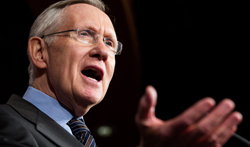Battle Heats Up Once Again Over Extension of Unemployment Benefits
12 March 2014

Unemployment benefits expired at the end of 2013 for about 1.3 million workers, and thus far Congress hasn’t taken action to extend them. While normally unemployment benefits a function of state legislature appropriations, they became a Washington, D.C. issue when Congress created the Emergency Unemployment Compensation program to extend state unemployment benefits past the usual 26 weeks.
Beginning in 2008, in response to the deepening financial crisis and massive increases in unemployment at that time, Congress moved to try to stabilize the economy by picking up the entire cost of extended benefits beyond the 19 to 26 weeks authorized by the states. In some circumstances, the federal funding enabled unemployment benefits to last as long as 99 weeks – or nearly two years.
With the passage of the deadline, though, the maximum length that states abruptly dropped from over 40 weeks in the vast majority of states (only North Carolina excepted) to just 26 weeks. And in Missouri, Arkansas, North Carolina, South Carolina, Georgia and Florida, that number’s going to be even lower, according to the Center on Budget and Policy Priorities.
That means that in addition to the 1.3 million of workers dumped off of unemployment benefits in December, we’re going to see an additional 1.9 million workers fall from the rolls in the first half of 2014 – and another 1.6 million in the last six months of the year. In all, nearly 5 million workers will get tossed from unemployment benefits, absent some significant improvements in job creation that can put them to work before that.
The Wall Street Journal published a map that depicts which states will be hit the hardest. The states with 1.5 percent or more of their work force on extended benefits include California, Nevada, Georgia, Illinois, Massachusetts, Connecticut, New York and Pennsylvania – with Michigan, Mississippi, Kentucky and Oregon not far behind.
Meanwhile, job creation in the U.S. seems to have stalled in December, with only 74,000 jobs created nationwide. The slowdown continued in January, with 113,000 jobs created – insufficient to keep up with working-age population growth, and sharply down from the 200,000+ numbers posted earlier in the winter, and the worst two-month figures since 2010. The workforce participation rate is now just 63 percent. That is, nearly 4 in 10 adults are out of the workforce, and not even looking.
That said, there is some good news for those who are still depending on these extended benefits: The fact that California, New Jersey, New York, Pennsylvania and Illinois are all in line to take it on the chin from the loss of federal subsidies for unemployment benefits means that there is a lot of natural Congressional support for renewing funding in the House of Representatives – counteracting the effect of a GOP majority in that body. The Democrat-led Senate, at the end of the day, will not be much of an obstacle. Democrats generally support the funding, while Republicans are more skeptical of the $26 billion cost.
There is, however, a deeper layer of politics to contend with. Here’s why:
The GOP’s plan for midterm election domination hinges on clobbering the Democrats with the many failures of Obamacare. And with the President’s approval rating dipping into the 30s, it seems likely that this could be a successful strategy.
The Democrats, however, are looking for an antidote – and they may have found one in the form of income inequality. The Democrats would love to pivot the national conversation from Obamacare to issues like income inequality, same sex marriage and discrimination issues, the minimum wage, and yes, a populist appeal to labor, both employed and unemployed.
For this reason, the Democrats may want to keep the issue alive a little longer. They will get no traction and no mobilization of their voting base if they “solve” the issue too soon.
The Republicans would probably rather give ground on the unemployment compensation issue if they can put it to bed early and take it off the table by the midterm elections.




